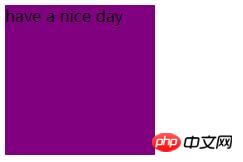 Web Front-end
Web Front-end
 CSS Tutorial
CSS Tutorial
 What is the difference between link and @import when introducing CSS files into html?
What is the difference between link and @import when introducing CSS files into html?
What is the difference between link and @import when introducing CSS files into html?
Previously introduced How to introduce CSS files into HTML. There are four ways to import CSS into HTML, namely inline, embedded, and external styles. External styles are divided into import style and link style. It is also an external style, so what is the difference between link and @import? Those who want to know, please continue reading below.
1. Differences in import methods
link link type:
<link rel="stylesheet" type="text/css" href="css/green.css"/>
import import type:
<style type="text/css">
@import url("css/green.css");
</style>II , Differences in browsers
link will not cause compatibility issues, while @import needs to be implemented in IE5 or above.
During the page loading process, if it is a CSS style file imported by link, the CSS style will be loaded at the same time as the content. If it is a CSS file introduced by @import, the style will be loaded after the page is loaded.
3. Differences in dependency relationships
@import is a syntax rule provided by CSS and only has the function of importing style sheets. Link is a tag provided by HTML. It can not only load CSS files, but also define RSS, rel connection attributes, etc.
4. Differences in DOM control style
When you need javascript to control the DOM to change the style, you can only use the link tag, because @import cannot be controlled by the DOM.
5. The difference between CSS priorities
The priorities of CSS styles with equal weight from high to low are: inline style, inline style, and external style. , import styles. If both the external link style and the imported style have a div{color:XX}, the final div style is the div style defined in the external link style.
Example: Give the div inline style, inline style, external style, and imported style respectively to see what effect it will have in the end.
<link rel="stylesheet" type="text/css" href="css/green.css"/> have a nice day
Rendering:

<!DOCTYPE html>
<html>
<head>
<meta charset="UTF-8">
<title></title>
<style type="text/css">
div{background: yellow;}
@import url("css/red.css");
</style>
</head>
<body>
<div style="width: 150px;height: 150px;">have a nice day </div>
</body>
</html>
CSS. In general, it is best not to use the import import style. If the style loaded by the import is relatively large, it is easy to load. Delay and even screen flickering. For now, it is recommended for small websites to use link import. Of course, if we need to modularize CSS in the future, @import will be used. This depends on the situation.
The above is the detailed content of What is the difference between link and @import when introducing CSS files into html?. For more information, please follow other related articles on the PHP Chinese website!

Hot AI Tools

Undresser.AI Undress
AI-powered app for creating realistic nude photos

AI Clothes Remover
Online AI tool for removing clothes from photos.

Undress AI Tool
Undress images for free

Clothoff.io
AI clothes remover

AI Hentai Generator
Generate AI Hentai for free.

Hot Article

Hot Tools

Notepad++7.3.1
Easy-to-use and free code editor

SublimeText3 Chinese version
Chinese version, very easy to use

Zend Studio 13.0.1
Powerful PHP integrated development environment

Dreamweaver CS6
Visual web development tools

SublimeText3 Mac version
God-level code editing software (SublimeText3)

Hot Topics
 Table Border in HTML
Sep 04, 2024 pm 04:49 PM
Table Border in HTML
Sep 04, 2024 pm 04:49 PM
Guide to Table Border in HTML. Here we discuss multiple ways for defining table-border with examples of the Table Border in HTML.
 Nested Table in HTML
Sep 04, 2024 pm 04:49 PM
Nested Table in HTML
Sep 04, 2024 pm 04:49 PM
This is a guide to Nested Table in HTML. Here we discuss how to create a table within the table along with the respective examples.
 HTML margin-left
Sep 04, 2024 pm 04:48 PM
HTML margin-left
Sep 04, 2024 pm 04:48 PM
Guide to HTML margin-left. Here we discuss a brief overview on HTML margin-left and its Examples along with its Code Implementation.
 HTML Table Layout
Sep 04, 2024 pm 04:54 PM
HTML Table Layout
Sep 04, 2024 pm 04:54 PM
Guide to HTML Table Layout. Here we discuss the Values of HTML Table Layout along with the examples and outputs n detail.
 Moving Text in HTML
Sep 04, 2024 pm 04:45 PM
Moving Text in HTML
Sep 04, 2024 pm 04:45 PM
Guide to Moving Text in HTML. Here we discuss an introduction, how marquee tag work with syntax and examples to implement.
 HTML Ordered List
Sep 04, 2024 pm 04:43 PM
HTML Ordered List
Sep 04, 2024 pm 04:43 PM
Guide to the HTML Ordered List. Here we also discuss introduction of HTML Ordered list and types along with their example respectively
 How do you parse and process HTML/XML in PHP?
Feb 07, 2025 am 11:57 AM
How do you parse and process HTML/XML in PHP?
Feb 07, 2025 am 11:57 AM
This tutorial demonstrates how to efficiently process XML documents using PHP. XML (eXtensible Markup Language) is a versatile text-based markup language designed for both human readability and machine parsing. It's commonly used for data storage an
 HTML onclick Button
Sep 04, 2024 pm 04:49 PM
HTML onclick Button
Sep 04, 2024 pm 04:49 PM
Guide to HTML onclick Button. Here we discuss their introduction, working, examples and onclick Event in various events respectively.





